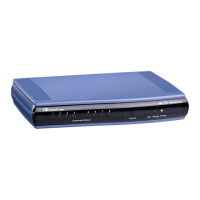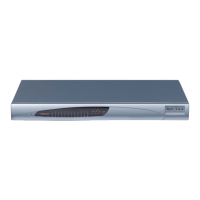Management;
InterfaceTable 1 = 2, 0, 200.200.85.14, 24, 0.0.0.0, 200,
Control;
InterfaceTable 2 = 1, 0, 211.211.85.14, 24, 211.211.85.1, 211,
Media;
The above example, configures three network interfaces
(OAMP, Control, and Media).
Notes:
For this parameter to take effect, a device reset is required.
For a description of this parameter, see 'Configuring IP
Network Interfaces' on page 105.
Single IP Network Parameters
Web: IP Address
EMS: Local IP Address
[LocalOAMIPAddress]
Defines the device's source IP address of the operations,
administration, maintenance, and provisioning (OAMP) interface
when operating in a single interface scenario without a Multiple
Interface table.
The default is 0.0.0.0.
Note: For this parameter to take effect, a device reset is
required.
Web: Subnet Mask
EMS: OAM Subnet Mask
[LocalOAMSubnetMask]
Defines the device's subnet mask of the OAMP interface when
operating in a single interface scenario without a Multiple
Interface table.
The default subnet mask is 0.0.0.0.
Note: For this parameter to take effect, a device reset is
required.
Web: Default Gateway Address
EMS: Local Def GW
[LocalOAMDefaultGW]
Defines the Default Gateway of the OAMP interface when
operating in a single interface scenario without a Multiple
Interface table.
VLAN Parameters
Web/EMS: VLAN Mode
[VLANMode]
Enables VLANs tagging (IEEE 802.1Q).
[0] Disable (default)
[1] Enable
Notes:
For this parameter to take effect, a device reset is required.
To operate with multiple network interfaces, VLANs must be
enabled.
VLANs are available only when booting the device from
flash. When booting using BootP/DHCP protocols, VLANs
are disabled to allow easier maintenance access. In this
scenario, multiple network interface capabilities are
unavailable.
Web/EMS: Native VLAN ID
[VLANNativeVLANID]
Defines the Native VLAN ID. This is the VLAN ID to which
untagged incoming traffic is assigned. Outgoing packets sent to
this VLAN are sent only with a priority tag (VLAN ID = 0).
When the Native VLAN ID is equal to one of the VLAN IDs listed
in the Multiple Interface table (and VLANs are enabled),
untagged incoming traffic is considered as incoming traffic for
that interface. Outgoing traffic sent from this interface is sent
with the priority tag (tagged with VLAN ID = 0).
